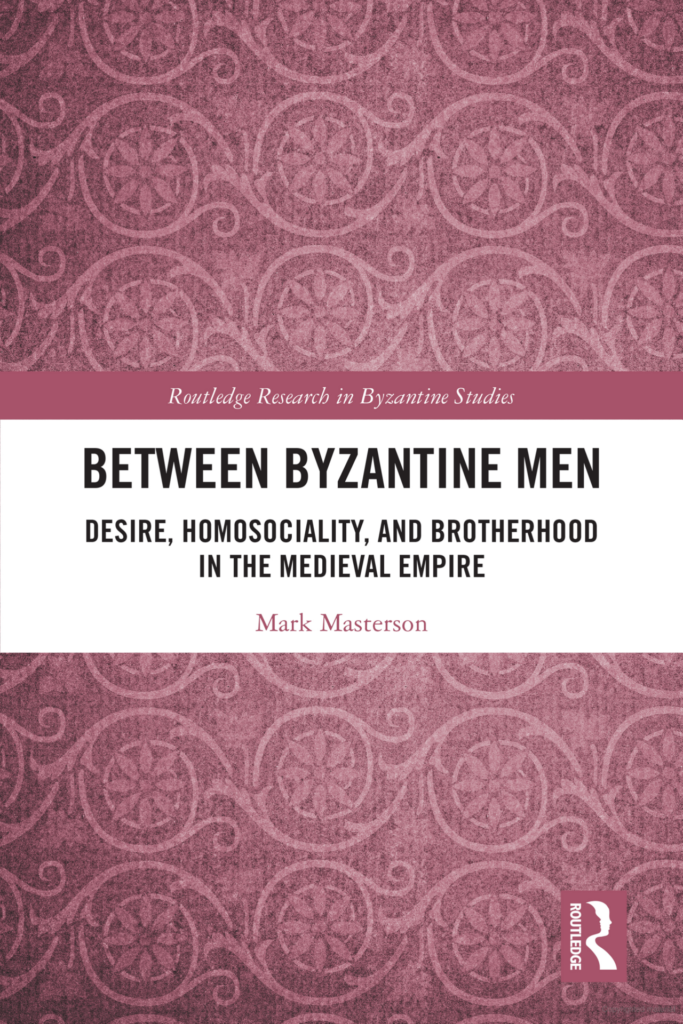Mark Masterson

NOTCHES: In a few sentences, what is your book about?
Mark Masterson: Between Byzantine Men: Desire, Homosociality, and Brotherhood in the Medieval Empire is about relations between men who wrote letters to each other and histories in the imperial capital, Constantinople, from about 940 to just after 1000. The role played by same-sex desire in their relations with each other and in the histories they wrote is the consistent focus. The book identifies these relations as the site of a discourse that affirms same-sex desire and runs counter to discourses found in ecclesiastical and legal sources. The book situates ritual brotherhood (adelphopoiesis) within this milieu. This church rite does not license carnality between brothers, it, rather, gives ecclesiastical sanction to a relation that may or may not already have a desiring dimension. The rite does not make a relation, but solemnizes it and provides an articulation point. Throughout the book, I place front and center evidence in the sources of pleasure, desire, and connectedness between men. The book is a story of these things.
NOTCHES: You focus in particular on Emperors Basil I and Basil II. Can you tell us a bit about them, and especially about the role of same-sex desire in their lives and reigns?
MM: Basil I was the founder of the glorious Macedonian dynasty in the 800s. He was poor and of no-account and made his way to the throne via ritual brotherhoods with various men. He was handsome, and histories of him written in 900s feature same-sex desire. I believe the historians imagined Basil I’s life (and a very sexy imperial court) in terms familiar to themselves. Basil II was the military-minded emperor from the fifth generation of the Macedonian dynasty. Basil II is regarded as one of the empire’s most glorious emperors. On the throne for 49 years (976-1025), he notoriously never wed. He was the only emperor in over a thousand years not to do so. I discuss this fact and unearth a discourse that plausibly attributes desire for men to him.
NOTCHES: You talk about the role of homosociality and brotherhood in elite Byzantine culture. Where does same-sex desire fit into this picture- was sex just another way to reinforce bonds between men?
MM: Same-sex desire and sex were always possibilities in these circles. The Byzantines talk about them a lot. While they certainly would have reinforced bonds between men, I think the sources show that desire and sex were valued for themselves and as expressions of regard. There were not just “a means”, they were, if I may say so, “things”.
NOTCHES: Is it fair to say that the Byzantine world was more sexually liberal than the medieval West? And if so, why? And was this freedom extended to all, or limited to elite men?
MM: I believe it definitely was more liberal. I think the reason for this is that the Byzantines, especially as learning and cosmopolitanism came to the fore in the 800s and 900s, felt a connection to the Greece of Socrates and Alexander the Great, which was a time hospitable to same-sex desire. Additionally, the 900s was a time of social mobility, which meant that there needed to be ways for men to bridge status asymmetries on their way up. Relations of same-sex desiring regard were one way unequal men could meet. Same-sex desire also mediated between men who were eunuchs and those who were not. (Eunuchs are discussed a fair bit in the book, I will add here.) While the evidentiary situation vis-à-vis non-elite men is difficult, I believe that it was not just an elite thing. Basil I was obviously aware of the possibilities of desire between men when he was very poor, for example.
NOTCHES: How did religion fit into the picture, both in terms of the Church’s stance on same-sex desire and how the men themselves reconciled their sexuality and their religious contexts?
MM: This is an important question. My answer to this is simple: the empire was a big place and competing discourses meeting different needs coexisted, i.e., men needed affiliation so desire found support versus the church wanted men to hew to Pauline sexual injunctions. As the totality of modern reality is complicated on such questions, so was the Byzantine medieval one. All this said, I argue not only from secular sources but frequently also from the Old and New Testaments.
NOTCHES: What drew you to this topic? Why does this history matter today?
MM: I was drawn to this topic because I believe it is of vital importance to narrate the realities of the past in the matters of sex and desire. We cannot let the straight-washers, who are not just right-wing ideologues alas, deprive us of history that prefigures in some ways the sexual system we have now. What happened back then is not the same of course, but there are commonalities. The propensity for men to desire each other and have sex with one another is always with us, and we must not allow that history to be denied. It is the oppressors who must be denied their prejudicial resort to (false) historical precedent.
NOTCHES: What questions do you still have? Were there any stories/ topics you had to leave out, or anything you wish you could have included?
MM: I still have questions about the women in these men’s lives, as there are married men in this mix. That said, the 900s source material trends toward very male, so mostly silences are to be found. An investigation into the next century, in contrast, will show that homoeroticism continues amid a more pronounced presence of women. (I may go there next in my work.) In terms of what had to be left out of the book, to preserve the flow I pared back theoretical musings on the relation of my project to queer theory (this will appear in later work, I think in a book chapter or article) and, elsewhere, a discussion of the ways some of the historians from the 900s conceived of their histories. I also could have said more about the many letters of Symeon the Logothete. I only discussed two, one of which, though, is a banger.
NOTCHES: How did you research the book? (What sources did you use? Were there any especially exciting discoveries, any particular challenges, etc.)
MM: I worked from editions of letters, histories, laws, penitentials, Byzantine encyclopaedias, saints’ lives, brotherhood prayers, and general ecclesiastical works published as early as the 1700s to ones published in the last few years. I was especially grateful for the latter. Most of the time, these sources were only the Greek texts, and I had to do my own translations. I did not mind so much as one gains an intense knowledge of exactly what the source says, which in turn suggests possible arguments and also tells you what you cannot say! A challenge in general was the time it takes to do all of this. A particular challenge was constructing arguments from six tenth-century historiographies (one of which had three versions). I also argued from figures appearing on ivory boxes (the “Veroli” and “Cluny” caskets) and from illustrations in an eleventh-century manuscript (The “Madrid Skylitzes”).
NOTCHES: How do you see your book being most effectively used in the classroom? What would you assign it with?
MM: I think Between Byzantine Men would be a good text in courses which are considering homosociality and desire between men in history. The introduction would suit an advanced course that wanted to think through the (undoubted) benefits of queering historiography. My position on this will provoke some discussion, I think. I don’t use the word queer in this book, while absolutely being in agreement with many queer theorists on the need to reject the now fraying Foucauldian position that modern sexuality has no meaningful relation to historical analogues. I would assign my book with Eve Kosofsky Sedgwick (as the book’s title suggests) and with Gayle Rubin. There will be continuities and discontinuities which will be worth discussing. I would also assign it with Marcella Althaus-Reid’s Indecent Theology, a work that I discuss at some length in the introduction. Between Byzantine Men would also benefit from juxtaposition with Roland Betancourt’s recent Byzantine Intersectionality, which I reviewed in The Byzantine Review.
NOTCHES: What are you working on now this book is published?
MM: As noted above, this warm homosocial culture continues into the 1000s, and women become more visible. There are many sources available from this time period (even more than the 900s), and there is the presence of one of the superstars of Byzantine letters: Michael Psellos. Between Byzantine Men initially was going to include the 1000s, but it emerged early on that there was more than enough to keep me busy in the 900s. This may be the next place I go. It will not be quick, however, as, like before, most of the sources are untranslated. I will have my work cut out for me, but I do enjoy translating.
 Mark Masterson is Associate Professor of Classics at Te Herenga Waka/Victoria University of Wellington, New Zealand. He is author of Between Byzantine Men: Desire, Homosociality, and Brotherhood in the Medieval Empire (Routledge 2022) and Man to Man: Desire, Homosociality and Authority in Late-Roman Manhood (Ohio, 2014). He also was one of three editors of Sex in Antiquity: Gender and Sexuality in the Ancient World (Routledge, 2014). He tweets from @MarkJMasterson
Mark Masterson is Associate Professor of Classics at Te Herenga Waka/Victoria University of Wellington, New Zealand. He is author of Between Byzantine Men: Desire, Homosociality, and Brotherhood in the Medieval Empire (Routledge 2022) and Man to Man: Desire, Homosociality and Authority in Late-Roman Manhood (Ohio, 2014). He also was one of three editors of Sex in Antiquity: Gender and Sexuality in the Ancient World (Routledge, 2014). He tweets from @MarkJMasterson

NOTCHES: (re)marks on the history of sexuality is licensed under a Creative Commons Attribution-NonCommercial-NoDerivatives 4.0 International License.
Based on a work at www.notchesblog.com.
For permission to publish any NOTCHES post in whole or in part please contact the editors at NotchesBlog@gmail.com




